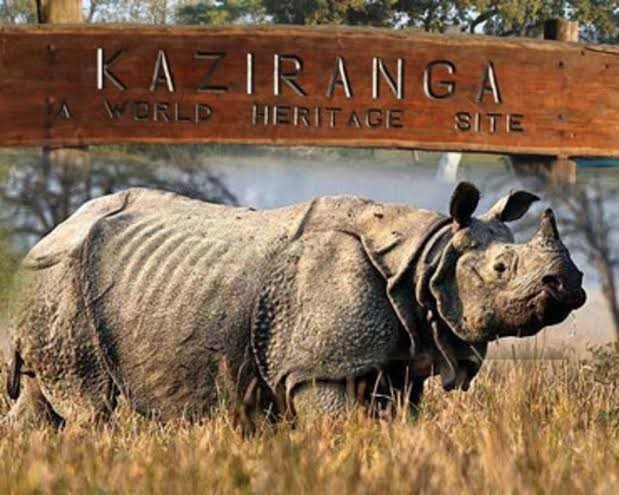
Kaziranga National Park

Kaziranga National Park , RACE IAS : Best IAS Coaching in Lucknow , Daily Current Affairs
|
For Prelims: Kaziranga National Park , Other national parks in Assam For mains GS paper 3: Kaziranga Project – Indo-French partnership , One -horned Rhino,Flora and fauna in Kaziranga National Park, UNESCO |
Why in the news?
Recently, the Kaziranga National Park and Tiger Reserve reopened with a literary tribute to a British-era forest officer Patrick D. Stracey who rid its name of any hunting connotations.
About Kaziranga National Park:
- It was declared as a National Park in 1974.
- It has been declared a tiger reserve since 2007. It has a total tiger reserve area of 1,030 sq km with a core area of 430 sq. km
- It is located in the state of Assam.
- It is part of the Eastern Himalayan biodiversity hotspots.
- It is also a UNESCO World Heritage Site and houses two-thirds of the total world population of greater one-horned rhinoceros.
- It is recognized as an Important Bird Area by BirdLife International for the conservation of avifaunal species.
- It is located in the floodplain of the Brahmaputra river in the districts of Nagaon, Golaghat, and Sonitpur in Assam.
- It is the largest protected area on the Brahmaputra river’s southern bank.
- National Highway 37 passes through the park area.
- The Diphlu River passes through the Kaziranga National Park, there are over 250 seasonal water bodies in the park.
Flora in Kaziranga National Park
- The flora of Kaziranga National Park is categorized into three types 1)alluvial inundated grasslands 2)tropical wet evergreen forests 3)tropical semi-evergreen forests.
- The national park is primarily popular for its dense and tall elephant grasses intermixed by small swamplands which are left behind by the receding flood waters of the river Brahmaputra.
- It also includes an abundant cover of water lilies, water hyacinth and lotus.
- Rattan Cane, which is a type of climbing palm, also adds to the beauty of Kaziranga wildlife sanctuary.
Fauna in Kaziranga National Park
- The land of Kaziranga boasts the largest population of greater one-horned rhinos and wild water buffaloes.
- The national park is home to Royal Bengal Tigers, swamp deer, Asian elephants which along with one-horned rhinos and wild water buffaloes form the Big Five.
- Kaziranga is also inhabited by 30+ mammalian species out of which 15 species of animals come under the threatened category.
- It is one of the last homes of the critically endangered Bengal florican.
- The national park is also rich in the population of avifauna.
Popular Species of Reptiles Found in Kaziranga
Snakes,LizardsTortoises,Alligator (Gharial),Crocodile
Kaziranga Project – Indo-French partnership
- The Kaziranga project is a component of the more comprehensive Assam Project on Forest and Biodiversity Conservation, for which the Agence Française de Développement has contributed €80,2 million over ten years, from 2014 to 2024.
- Artificial highlands that allow animals to escape floods, interaction with local people and training in alternative livelihoods for them.
- Conservation of biodiversity via reforestation of 33,500 hectares of land and wildlife management ( 457sq km Kaziranga National Park)
- The illicit wood trade is one of the primary causes of deforestation surrounding the reserve. Kaziranga’s “protection strategy” includes the establishment of 223 anti-poaching camps around the park.
- There are thirty-five six-and-a-half-foot-tall embankments or highlands created throughout the park on which animals can climb and seek refuge during the annual flooding.
- The initiative has also created infrared-based early warning devices, activated by elephant footfall, to either frighten elephant groups away from human habitat or alert villages.
Other national parks in Assam are:
- Dibru-Saikhowa National Park
- Manas National Park
- Nameri National Park
- Rajiv Gandhi Orang National Park.
About the One -horned Rhino:
- The greater one-horned rhino (or “Indian rhino”) is the largest of the rhino species.
- It is found in Nepal, Bhutan, Pakistan and India.
- It is Vulnerable in the IUCN Red List and lies in Schedule I of the Wildlife Protection Act.
- It is in Appendix I of the Convention on International Trade in Endangered Species of Wild Fauna and Flora (CITES):
- India is home to over 85 % population. It is found in UP, West Bengal and Assam.
- According to WWF data from 2012, Assam has 91 % of the total Rhino in India which is mainly concentrated in Kaziranga National Park, and Pobitora Wildlife Sanctuary. Others include Manas Tiger Reserve, Orang Tiger Reserve and Laokhowa Reserved Forests
There are five rhino species:
- Great One horned rhino- Vulnerable in the IUCN Red List.
- White rhinos – near threatened in the IUCN Red List.
- Black rhinos in Africa – critically endangered in the IUCN Red List.
- Javan rhino- Critically endangered in IUCN Red List.
- Sumatran rhinos- extinct.
UNESCO
- The United Nations Educational, Scientific and Cultural Organization (UNESCO) is a specialised agency of the United Nations (UN) aimed at promoting world peace and security through international cooperation in education, arts, sciences, and culture.
- It was founded in 1945 as the successor to the League of Nations’ International Committee on Intellectual Cooperation.
- It has 193 member states and 11 associate members, as well as partners in the non-governmental, intergovernmental, and private sector.
- Headquartered at the World Heritage Centre in Paris
- UNESCO's founding mission is to advance peace, sustainable development and human rights by facilitating collaboration and dialogue among nations.
Source:The Hindu